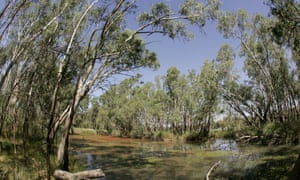Exclusive: Analysis shows federal and state environment spending cut while industry awarded $2.5bn in fuel tax credits
The analysis by the Australian Conservation Foundation (ACF) found that, across commonwealth, state and territory governments, investment in environment and biodiversity programs was cut by 9% – from $6.95bn to $6.32bn – in the three years to 2016-17. Total budget spending rose by 10% in the same period, from $634.9bn to $701.5bn.
It adds to a weight of evidence that environment campaigners and political veterans say shows government support for environment protection is at its lowest ebb since before the landmark decisions to protect Kakadu, the Daintree rainforest and the Franklin river in the 1980s.
ACF economist Matt Rose said it was distressing that public investment in the environment was being slashed while government budgets were rapidly growing.
“It shows that our elected representatives have made a clear decision to devalue our natural world and safe climate at a time when they are under enormous strain,” he said. “It robs people of the funding needed to make a practical difference for our environment through programs like land restoration, tree planting and removing invasive species.”
An initial ACF analysis released in December found the federal environment department budget was slashed by 30% over the past three complete financial years, with further cuts planned out to 2020-21.
A new paper by the same group says that while the federal environment department’s budget had been cut to a projected $950m, the commonwealth is expected to award the mining sector $2.5bn in fuel tax credits this year. An estimated $980m of that would go to coal companies.
Under legislation introduced in 2006, some businesses are able to claim the cost of the excise paid on various fuels (40.1 cents a litre for liquid fuels such as diesel) back as a credit against their tax. It has been justified on the grounds the excise is used to fund roads, and mining and agricultural businesses should not have to pay it for fuel used in off-road vehicles. Funding raised from the excise mostly goes into general budget revenue, which may or may not include roads.
The policy has bipartisan support, but it has long been opposed by the Greens and environment groups. Rose said it meant some of the world’s biggest companies including BHP Billiton, Rio Tinto and Glencore paid no tax on the fuel they used to extract and sell Australia’s minerals while environment and other departments endured deep cuts.
The commonwealth’s state of the environment report last year found parts of Australia’s natural estate were in poor or deteriorating condition and there was insufficient public support for environmental management and restoration programs.
"Our elected representatives have made a clear decision to devalue our natural world and safe climate"
Federally, biodiversity funding and the long-running Landcare program to tackle land degradation are facing the biggest annual cuts. Landcare has had what was once $1bn funding over four years spread over six, equivalent to a 33% reduction. Tony Abbott’s long-promised $525m green army program was launched but is now being shut with less than half its budget spent. About $225m of green army funding was reclaimed as a budget saving, and $100m went back to Landcare under a deal with the Greens in return for their support for a backpacker tax.
Frydenberg said the government was investing billions in Landcare, the emissions reduction fund that pays businesses and farmers to cut carbon dioxide emissions as well as protecting the Great Barrier Reef, which recently received an additional $60m, in part for research into making coral more resilient.
“We are also developing smarter policies to galvanise more action for the environment,” he said. “For example, the Coalition’s threatened species strategy identifies those key species the government is seeking to prioritise for investment and calls on partners from other sectors to co-invest.”
The ACF report finds the environment cuts in Canberra have coincided with a smaller reduction at state and territory level. Across the eight jurisdictions, environment spending was cut 5% over the past three years.
That may be reversed if commitments for the current financial year are delivered. State and territory governments have promised to restore and increase environment funding to a level 5% higher than it was in 2013-14. Their total budget spending is growing even more rapidly, up by a projected 19% over the same period.
The biggest cut has been in Victoria, where spending across three agencies was cut 10%, mainly due to the state Environment Protection Authority losing a third of its funding. Western Australia’s environment budget declined by 7%, though the new McGowan Labor government said it would boost it this year by about $10,000 to a level 4% lower than it was in 2013-14.
The Northern Territory was the only jurisdiction to increase environmental spending as a proportion of its total budget since 2013. Queensland has increased environmental spending 10% since deep public service cuts by the Newman LNP government in 2013, but not at the rate at which it has been restored to other areas. New South Wales’ environment spending was flat over the three years while overall spending has grown 14%.
He welcomed the fact the states were projected to reverse some environment cuts, but said experience showed budget projections were not always realised. “We need to reserve judgment until the greater investment is delivered,” he said.
The ACF said the lack of a clear framework for environmental budget accounting complicated the process of working out what constituted environmental spending. Information used in the analysis was largely drawn from budget papers.

No comments:
Post a Comment